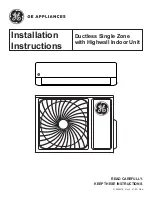
5 Cold Weather Operations
5 Cold Weather Operations
W W W . B A L T I M O R E A I R C O I L . E U
23
COLD WEATHER OPERATIONS
About cold weather operation
BAC equipment can be operated in subfreezing ambient conditions provided the proper measures are taken:
1. Insulation of piping.
2. Protection against coil freezing.
3. Elimination of ice due to sub-freezing ambient.
Listed below are general guidelines which should be followed to minimize the possibility of freeze-up. As these
guidelines may not include all aspects of the anticipated operation scheme, system designer and operator must
thoroughly review the system, location of the equipment, controls and accessories to ensure reliable operation at
all times.
When tanks are installed outdoors and exposed to subfreezing conditions, a minimum heat load must be applied to
the TSU to avoid solid ice formation inside the tank and prevent damage.
Protection of operating control assembly
When the thermal storage unit will be exposed to subfreezing ambient temperatures, the Operating Control
Assembly, the sight tube assembly and, if so equipped, the Ice Inventory Sensor must be protected.
The sight tube and optional inventory sensor must be heat traced and insulated. It is not necessary to drain the unit
during cold weather.
Insulation of piping
Precautions must be taken to protect the associated piping from freezing conditions. Heat tracing and insulation
should be installed on all piping connected to the unit to prevent cracking.
Protection against coil freezing
TSU Ice Thermal Storage coil(s) must be protected from damage by freezing of the fluid inside the coil(s) when in
operation. Freeze protection must be obtained by the use of ethylene or propylene glycol or other anti-freeze
solutions in appropriate concentrations.
TSU Ice Thermal Storage units typically use a 25% (by weight) solution of industrially inhibited ethylene glycol for
both corrosion and freeze protection. The systems lowest operating temperature should be at least 3°C to 4°C
above the anti-freeze solution freeze point. Uninhibited ethylene glycol and automotive antifreeze solutions are
NOT to be used in TSU Ice Thermal Storage coil(s).
The table below indicates the freeze protection range for various ethylene glycol concentrations (% by volume).
TSU-M
5
Содержание ICE CHILLER TSU-M
Страница 32: ...W W W B A L T I M O R E A I R C O I L E U 32...
Страница 33: ...W W W B A L T I M O R E A I R C O I L E U...
Страница 34: ...W W W B A L T I M O R E A I R C O I L E U...
Страница 35: ...W W W B A L T I M O R E A I R C O I L E U...
Страница 36: ...W W W B A L T I M O R E A I R C O I L E U...
Страница 37: ...W W W B A L T I M O R E A I R C O I L E U...
















































